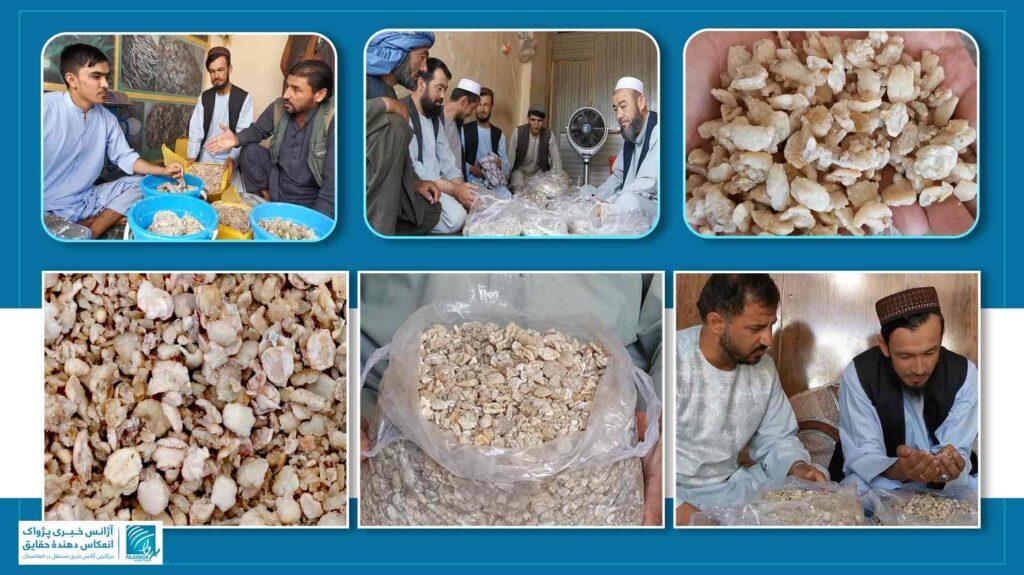Farmers Incur Losses Amid Sharp Decline In Asafetida Prices
AIBAK (Pajhwok): A number of farmers in northern Samangan province say they incurred financial losses this year due to a sharp decline in the price of asafoetida (locally known as hing) and the lack of a proper market for the medicinal plant.
They warn that without urgent attention from the government and national traders, their years of hard work will go in waste.
According to farmers, one kilogram of asafoetida resin, which in previous years sold for between 25,000 to 30,000 afghanis, is now being sold for only 3,000 to 4,000 afghanis.
Fida Mohammad, one of the asafoetida farmers in Samangan, told Pajhwok:“I work all the day on my land, but now our harvest has no value, and our efforts are going in vain.”
He noted that the current price did not even cover the basic expenses of farmers.
Fida Mohammad called on local officials and national traders to take action to raise the price of asafoetida, so that producers can sell their products at a fair rate.
Tash Murad, a resident of Dara-i-Suf Paeen district, who had brought two kilograms of asafoetida resin to the Aibak market, said:“I've been cultivating asafoetida for six years, and my entire family's livelihood depends on it. In the early years, I sold a kilo of resin for up to 35,000 afghanis, but now the price has dropped drastically.”
He added that in the past, asafoetida cultivation was driven by enthusiasm, as quality seeds were available and market prices were high.
Shujauddin, a local trader in Samangan, echoed the same concerns, saying:“This year, the price of asafoetida has dropped sharply. If this trend continues, both farmers and local traders will face significant losses.”
He urged the government to focus on marketing the crop and facilitating its access to international markets.
Experts view
Agricultural experts warn that if the government, in coordination with national traders, fails to engage with international partners to find long-term solutions, asafoetida could disappear from the market altogether.
Waheed Parsa, an agricultural expert and university professor, said that asafoetida cultivation is a viable and effective economic alternative to poppy farming in Afghanistan and has grown significantly in recent years.
He added that since the political transition, Afghanistan has faced major export challenges, and the lack of international recognition of the current government may be one of the key reasons why global traders are reluctant to import Afghan asafoetida.
According to Parsa, the government and national traders can play a critical role in stabilizing prices by attracting cooperation from international donors, foreign governments, and global traders. This would strengthen the national economy and support both local farmers and traders.
Abdul Khaliq Mubarez, head of the Samangan Chamber of Industries and Mines, confirmed the concerns of local farmers. He identified transit challenges-particularly at the Torkham border crossing-as one of the main reasons behind the price drop.
He stressed the need for serious government efforts to facilitate the export of asafoetida.
Local officials in Samangan say steps are being taken to help market the product.
Najib Khurram, Director of Medicinal Plants Regulation at the Department of Agriculture, Irrigation, and Livestock in Samangan, noted that although prices have fallen, asafoetida still retains a higher market value than many other crops.
However, he explained that increased supply coupled with decreased demand has created economic difficulties for farmers.
Khurram clarified that the department's role is to promote and support cultivation-not marketing. Nonetheless, he said that boosting exports could help stabilize or even increase prices.
“If the relevant institutions make an effort and exports improve, the market price of asafoetida resin will rise again,” he added.
Asafoetida, also known as hing or anqooza, is one of Afghanistan's key medicinal and export crops. Its cultivation has expanded significantly over the past decade. However, this year's dramatic price decline has raised serious concerns among both producers and traders about the future of the crop.
sa/ma

Legal Disclaimer:
MENAFN provides the
information “as is” without warranty of any kind. We do not accept
any responsibility or liability for the accuracy, content, images,
videos, licenses, completeness, legality, or reliability of the information
contained in this article. If you have any complaints or copyright
issues related to this article, kindly contact the provider above.
Most popular stories
Market Research

- Nutraceuticals Market Size Projected To Witness Strong Growth During 2025-2033
- Excellion Finance Scales Market-Neutral Defi Strategies With Fordefi's MPC Wallet
- Pluscapital Advisor Empowers Traders To Master Global Markets Around The Clock
- Meme Coin Little Pepe Raises Above $24M In Presale With Over 39,000 Holders
- Vietnam Vegan Food Market Size, Share, Trends And Report 2025-2033
- Red Lions Capital And Neovision Launch DIP.Market Following ADGM Regulatory Notification






















Comments
No comment